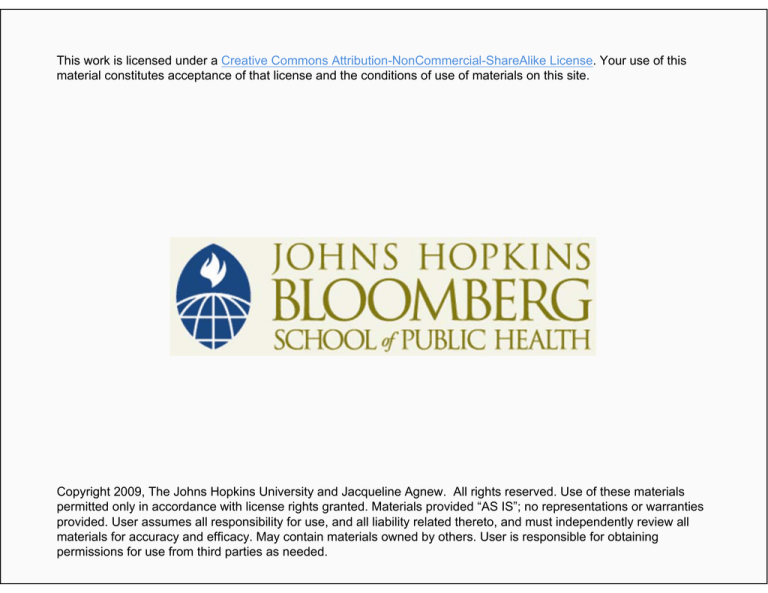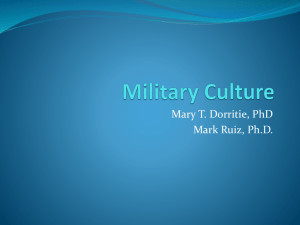
This work is licensed under a Creative Commons Attribution-NonCommercial-ShareAlike License. Your use of this
material constitutes acceptance of that license and the conditions of use of materials on this site.
Copyright 2009, The Johns Hopkins University and Jacqueline Agnew. All rights reserved. Use of these materials
permitted only in accordance with license rights granted. Materials provided “AS IS”; no representations or warranties
provided. User assumes all responsibility for use, and all liability related thereto, and must independently review all
materials for accuracy and efficacy. May contain materials owned by others. User is responsible for obtaining
permissions for use from third parties as needed.
Military Reservists
Jacqueline Agnew, RN, MPH, PhD
Johns Hopkins University
Section A
Mobilization Experience
Mobilization Experience
Total Guard/Reserve mobilized as of January 2009
Service
Total
Army Guard and Reserve
96,029
Navy Reserve
5,855
Air Guard and Reserve
16,161
Marine Corps Reserve
7,776
Coast Guard Reserve
843
Total
126,664
4
Who Is Being Mobilized?
All ages
Men and women
Jobs differ
Health status varies
5
Reservists—Unique Group
Hold civilian jobs as well as Reserve job
− Unique stressors
Most health care outside military system
Limited military influence on health behavior
− Standards—Army Physical Fitness Test (APFT), height/weight
−
Periodic physicals (5 years), health risk appraisals
Reservists don’t live on Army post
6
Quotes from Our Groups
“My family worries about deployment. It looms over us.”
The Reserves is “part of the reason I've been single.” “The reserves
isn't very conducive to a family lifestyle.”
7
The Employer’s Perspective
Study of employers’ perspective in response to soldiers’ concerns
Interviews with civilian employers post-911
Most in military police units
Some concerns of employers noted:
− Call came too quickly
−
−
−
−
Call came at an inconvenient time
Absent too long
Did not return when expected
Length of assignment was unclear
Source: Allison-Aipa et al. (2005). Mil Med.
8
Prior to Activation
Be aware of who belongs to the Guard/Reserves
Employees should have copies of relevant health information
− Record of immunizations
−
−
−
Documentation of allergies
List of medications
Known conditions (records from care givers)
Encourage to have meds, glasses, other devices
Remind to formally notify organization of mobilization—impending
and actual
9
Family Concerns
Photo by John Tuttle, Operation Desert Shield.
10
What Happens Once Mobilized?
Administrative—process onto active duty
− Eligible for medical care, also TRICARE
Screening
−
−
Plan for finances, family
Health—depends heavily on history, may be sent home
Immunizations
Limited briefings on potential health hazards
11
Section B
Physical and Mental Health Effects
Physical and Mental Health Effects
Spc. Nicholas Williams, who was wounded in Iraq in July 2007,
works out with his new prosthetic leg at WRAMC s Military
Advanced Training Center, which opened in September 2007.
Photo is Public Domain.
13
Non-Battle Injuries
Approximately 60% of air evacuations in 2004
Public Domain.
14
Major Causes of Non-Battle Injuries
Fall and jumps
− 18.7%
−
Sports/physical training
− 18%
−
Motor vehicles
Basketball, football, PT
Motor vehicle
−
15%
Source: Hadley et al. (2004).
15
Terms for Mental Heath Effects of War
Korean War era and before: shell shock
Vietnam era: combat fatigue
Current era: combat stress
16
Post Traumatic Stress Disorder: Symptoms
Three distinct groups of symptoms
− Intrusion
−
−
Avoidance
Hyperarousal
17
Intrusion Symptoms “Reliving”
Recurrent distressing memories of the event
Recurrent dreams of the event
Flashback episodes, where the event seems to be recurring
Bodily reactions to situations that remind them of the traumatic
event
18
Avoidance Symptoms
Inability to remember important aspects of the trauma
Lack of interest in normal activities
Feelings of detachment
Sense of having no future
Emotional “numbing,” or feeling as though they don’t care about
anything
Reduced expression of moods
Staying away from places, people, or objects that remind them of
the event
19
Hyperarousal Symptoms
Irritability or outbursts of anger
Sleeping difficulties
Difficulty concentrating
Exaggerated response to things that startle them
Hypervigilance
20
Defining PTSD
Veterans Administration
National Center for Post Traumatic Stress Disorder
−
http://www.ncptsd.va.gov/ncmain/ncdocs/assmnts/ptsd_check
list_pcl.html
21
Section C
Results of Three Studies
Study
Study: Combat Duty, Mental Health Problems, and Barriers to Care
− Operations Iraqi Freedom and Enduring Freedom
− Combat arms
− 2,530 surveyed one week before deployment
− 1,962 after return (3–4 wks) from Afghanistan
− 894 after return from Iraq
− Anonymous survey: symptoms of depression, anxiety, PTSD,
alcohol problems, family problems, professional help, barriers
−
See Table 3: Perceived Mental Health Problems and Alcohol
Misue
Source: Hoge, C., et al. (2004). N Engl J Med, 351, 1, 13–22.
23
Focus of Recommendations
Early detection
Need and systems for mental health services
− Types and numbers of professionals
−
−
Location and model
Confidentiality
Overcoming stigma
Refining treatment options
−
−
Psychotherapy
Medications
Implications for delivering care in AD vs. VA systems
Research in these areas
24
Study
Study: Mental Health Problems, Use of Mental Health Services, and
Attrition from Military Service after Returning from deployment to
Iraq or Afghanistan
−
−
Post-deployment health assessments
X Mandated screening program
N = 304,000 returning from deployment
Assessed
X
X
X
X
X
Major depression and other problems
Referral for mental health problem
Use of mental health services
Attrition from service
Source: Hoge, Auchterlonie, and Milliken. (2006). JAMA.
25
Results
Any mental health problem
− Returning from Iraq: 19.1%
−
−
Associated with
− Leaving the service
−
−
From Afghanistan: 11.3%
Other locations: 8.5%
Combat experiences
Mental health care referral and utilization per year
X
35% from Iraq sought mental health services in the next
year—12% diagnosed with disorder
X
Less than 10% who received care came through referral
process
Rates of mental health problems similar for active duty (18%) and
Reserve/Guard (21%)
26
Study
Study: Longitudinal Assessment of Mental Health Problems among
Active and Reserve Component Soldiers Returning from the Iraq War
−
−
−
−
Cohort of 88,235 soldiers returned from Iraq
Active and Reserve/National Guard
Completed health risk assessment on return and approximately 6
months later
Assessed
X
X
Depression
PTSD
X
Suicidal/aggressive ideation
Interpersonal conflict—family or others
X
Alcohol screen
X
Source: Milliken, C. S., Auchterlonie, J. L., Hoge, C. W. (2007). JAMA, 14, 298, 18, 2141–2148.
27
Results
More mental health problems reported at later point in time
− Interpersonal conflict concerns
X
−
X
PTSD
X
−
Active: 11.8% to 16.7%
Reserve: 12.7% to 24.5%
Depression
X
X
−
Active: 3.5% to 14.4% (time of return to 6 months later)
Reserve: 4.2% to 21.1%
X
Active: 4.7% to 10.3%
Reserve: 3.8% to 13.0%
Overall mental health risk
X Active: 17.0% to 27.1%
X
Reserve: 17.5% to 35.5%
28
Traumatic Brain Injury (TBI)
29
Traumatic Brain Injuries (TBI): A Growing Concern
Accompany other injuries—seen in
30% of those with combat-related
injuries at WRAMC
Concern for those not otherwise
wounded—may not be recognized at
the time
What will happen over time?
30
Indicators of Mild Traumatic Brain Injury
Self-reported head injury
Being dazed, confused, or “seeing stars”
Symptoms—headache, dizziness, memory problems
Not remembering the injury
Losing consciousness
31
Study
Study: Mild Traumatic Brain Injury in U.S. Soldiers Returning from
Iraq
−
2,525 infantry soldiers—most had seen combat
X Most male
X
−
−
X
~50% under age 30
~50% junior enlisted
Self-administered survey 3–4 months after return from Iraq
Assessed
X
X
TBI (analyzed loss of consciousness separately)
PTSD
X
Depression
Health rating, medical appointments, missed work
X
Physical symptoms
X
Source: Hoge et al. (2008). N Engl J Med, 358, 5, 453–463.
32
Findings
About 15% had injury classified as TBI on screening survey
5% experienced loss of consciousness
TBI strongly associated with PTSD
Loss of consciousness also associated with depression
33
Other Associations
Loss of consciousness
− Lost work days
−
−
−
Medical visits
Physical symptoms
Other post-concussive symptoms
X Problems with memory, balance, concentration
X
Irritability, ringing in ears
Other changes in mental status
− Headache
−
Problems with balance, concentration
TBI strongly associated with PTSD
TBI and health symptoms thought to be mediated by PTSD and/or
depression
34
Implications
Sheer numbers
Self-reported TBI screen responses not specific for post-injury
problems
−
−
Can lead to a high percentage of false positives, large number of
referrals
Costs vs. benefits of screening?
Management of PTSD, depression, other related outcomes very
important
35
To Date …
Public awareness is growing
Studies have effectively changed policy
Go beyond focus on combat troops
Gradual recognition of Reserve/Guard role and their risks
36
Section D
Returning to Civilian Life
Returning Home
Photo: Jeff & Leigh & Sam. CC-BY-NC-ND
38
Re-entry and Emotional Health
May feel “at sea”
Interactions strained
− Co-workers not sure what to say
−
Soldier can interpret as indifference
X “Acted like I never left”
Afraid of looking weak, fearful, “crazy”
Family interactions may be difficult
Higher than average suicide rates
Possible symptoms of PTSD
− Estimated 50–70% will have some symptoms
39
PTSD Symptoms and Work Behavior
Problems concentrating
Anger, anxiety, withdrawal
Conflict with co-workers
Increased accidents/close calls
Drop in motivation
Trouble completing work
Tardiness, absenteeism
Substance abuse
40
Workplace Actions
Examine need for policies
Need some catch-up time
May need to re-enter gradually, flexible schedule
Ask expectations, what communication desired
Refer if necessary
Be a good listener
41
Benefits and Protection
Health care
− Provided while on active duty and 180 days after
−
−
Also provided for family, TRICARE
If “line-of-duty” injury or illness, eligible for care until
separation (then VA system)
Employment
−
Uniformed Services Employment and Reemployment Rights Act
(USERRA)
42
USERRA
Obligations of service member
− Must notify employer of mobilization: verbal or written
Provisions of USERRA—employer
−
−
−
−
Can request documentation if more than 30 days absence
Mandatory poster explaining rights (DOL)
Same job or equivalent in pay, status, seniority
Treat disabled as with Americans with Disabilities Act
43
Employer Support of the Guard and Reserve
Uniformed Services Employment and
Reemployment Rights Act (USERRA)
Ombudsmen who serve as a resource,
clarify the law and mediate if necessary
800-336-4590
http://www.esgr.org/
44
Vocational Rehabilitation and Employment Program
Vocational Rehabilitation and Employment Program (VR&E)
− Department of Veterans Affairs
−
Can help determine reasonable accommodations for disabled or,
if unable to resume previous job, help train, find new one
45
Helpful Sites
Web sites
− Federal employees rights and benefits
−
http://www.opm.gov/oca/compmemo/2001/2001-09A.asp
Transition Assistance Program—DOD, DOL, VA
X
X
−
−
−
−
X
www.turboTAP.org
Transition Guide for Guard/Reserve
http://www.vetsuccess.gov/ (VA)
X Describes Disabled Transition Assistance Program (DTAP)
www.military.com/deployment
Deployment Health Clinical Center (subscribe to newsletter)
www.pdhealth.mil
National Center for PTSD
X
X
http://www.ncptsd.va.gov/ncmain/index.jsp
46






